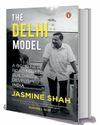
Most bureaucrats in the corridors of power in Delhi look forward to the summer. The pace of work gets a bit languorous and a good chunk, family in tow, go to their native places for that much-needed summer vacation. Many others take off to cooler climes—the lucky few to Europe and others to domestic hill stations and pilgrim centres.
A lazy summer becomes an even greater attraction in an election year. With the model code of conduct limiting the incumbent government from making any major decisions or policy changes and with ministers away campaigning, the pace of government work further slows down. It is usually a relaxed few weeks spent speculating on election results and extended tea breaks before the flurry of activity hits them in full blast with a new government.
This summer, though, things have been a bit different. The outgoing Narendra Modi government, in a show of super confidence in its fate at the hustings, has given them so much work that the bureaucracy’s hope for a ‘chill-out summer’ just melted away. It was set in motion way back in February. Modi initiated in a cabinet meeting the planning for a 100-day agenda that his government would take up after coming back to power. The plan was to be worked out by senior bureaucrats; a final list of 50 projects or policies to be taken up immediately after the new government’s formation, targeted at the grand vision of ‘Viksit Bharat’ by 2047.
Denne historien er fra June 02, 2024-utgaven av THE WEEK India.
Start din 7-dagers gratis prøveperiode på Magzter GOLD for å få tilgang til tusenvis av utvalgte premiumhistorier og 9000+ magasiner og aviser.
Allerede abonnent ? Logg på
Denne historien er fra June 02, 2024-utgaven av THE WEEK India.
Start din 7-dagers gratis prøveperiode på Magzter GOLD for å få tilgang til tusenvis av utvalgte premiumhistorier og 9000+ magasiner og aviser.
Allerede abonnent? Logg på

Forging the future
As the curtain falls on 2024, I take pride in the extraordinary milestones achieved under the leadership of Prime Minister Narendra Modi. This year stands as a testament to the Modi government's resolve to forge a resilient and forward-looking Bharat. From groundbreaking advancements in infrastructure to visionary global initiatives, these efforts resonate deeply with the vision of Viksit Bharat.

Our strange democracy
Abraham Lincoln is lauded as among the very best presidents the US ever had: the statesman par excellence successfully steered the nation through the devastating and perilous years of the American civil war. Not only did Lincoln manage to keep his country united, he also ensured the passage of the 13th amendment to the US constitution, which abolished slavery.

Five years of post-pandemic fashion
It has been five years since we discovered what Covid-19 was, and five years since it disrupted the world forever. The World Health Organization activated their emergency systems on January 1, 2020, and informed the world by January 4, 2020. By the end of that week, they had set guidelines for various countries to follow. Comparable to the Spanish flu of 1918, more than 7 million people have died of Covid according to official data. Unofficially, no one has an idea. WHO has just this week asked China to provide critical data to understand the virus's origins as a “moral and scientific imperative”.

Community spirit
Rhythm of Dammam opens a window to the world of African-origin Siddis of Uttara Kannada

'Breaking' down a scandal
Society Girl is not just a case study of a high-profile death in Pakistan but also a stark commentary on media trials

Progress card
Jasmine Shah's book tells you what the AAP has achieved in Delhi in the last 10 years

SENSE IN NONSENSE
In his latest book of poetry, Ruskin Bond is at his funniest

Get ready for Trump bump
The ‘butterfly effect’ is a beautiful, mysterious metaphor of the planet’s interconnectedness.

QUIET FLOWS THE FAITH
The melding of an ancient amorphous faith and the latest science; of an antique tradition and new practices; ways of life older than memory and new expressions is happening at Prayagraj in Uttar Pradesh.

Trash to treasure
How a weed-choked Dal Lake spurred Maninder Singh's journey to become a waste management visionary